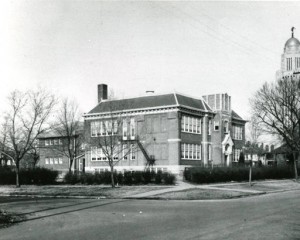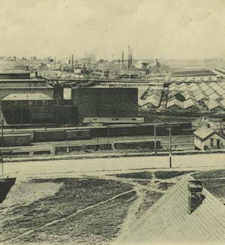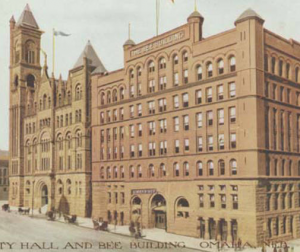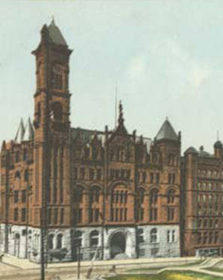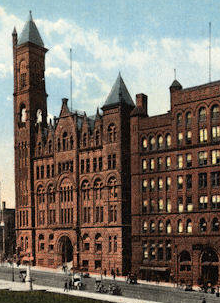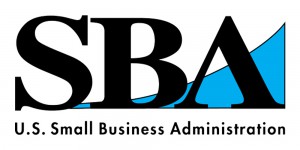Search the Blog
Categories
- Books & Reading
- Broadband Buzz
- Census
- Education & Training
- General
- Grants
- Information Resources
- Library Management
- Nebraska Center for the Book
- Nebraska Memories
- Now hiring @ your library
- Preservation
- Pretty Sweet Tech
- Programming
- Public Library Boards of Trustees
- Public Relations
- Talking Book & Braille Service (TBBS)
- Technology
- Uncategorized
- What's Up Doc / Govdocs
- Youth Services
Archives
Subscribe
Category Archives: Information Resources
Focus on Nebraska authors: Ted Kooser
Ted Kooser served as the United States Poet Laureate Consultant in Poetry to the Library of Congress from 2004–2006 and spoke in many venues around the state and the country during his tenure. I heard him speak at the Lied Center in Lincoln, NE and I recall him sharing that he had been compared to a hobbit. In fact, one of his speeches at Wartburg College in 2012 was entitled: American Hobbit or a Great Storyteller. In 2003, I helped select his title Local Wonders: Seasons in the Bohemian Alps, for the Nebraska Book Award for Nonfiction and as a One Book One Lincoln finalist in 2005. It was also selected as One Book One Nebraska for 2011. I have given copies of this book to many friends and family members. Here is my favorite quote from that book:
If you can awaken inside the familiar and discover it new you need never leave home. Local wonders.
I remember Ted sharing how he hoped to make poetry more ubiquitous and approachable to readers. If you reread the line above it may not register as poetry or at least, not the kind you dealt with in your high school or college literature classes. If your book group would like to branch out and read something besides a fiction or non-fiction selection, try Local Wonders. Have your readers pick their favorite parts and read them aloud at your discussion. You may do the very thing Kooser hoped he could accomplish and make a poetry lover out of you.
Posted in Books & Reading, General, Information Resources
1 Comment
The Data Dude – PLS Wi-Fi
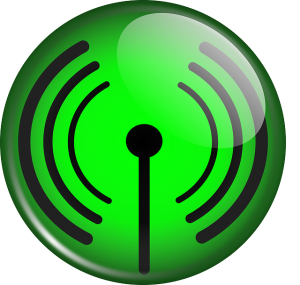 The Dude has been busy cleaning up data files from the public library survey (PLS) for submission to IMLS. Once the data is cleaned up, it will be posted on the NLC website. In the meantime, let’s review the new data element on this year’s public library survey that asked about the number of Wi-Fi sessions annually provided by Nebraska libraries. I know that reporting this data was problematic for many of you, so I appreciate you taking the time to collect and report it. The total number of Wi-Fi sessions for Nebraska libraries reported was 967,657. The Dude doesn’t have the complete data from this year’s survey, but for the sake of comparison, the total number of wired public computer uses in libraries last year was more than 2.2 million. It’s probably safe to assume the reported Wi-Fi number is much lower than reality. So, how do we get more accurate data collection next year? Some of you are already looking into technological solutions or methods to capture this data for next year’s survey. Thank you for doing that. Even if a technological solution (e.g. from your router or other software installed) is implemented, it is acceptable to take samples throughout the year (try and do it for different seasons of the year) and average them. Count what you see. In other words, if you see a couple of Dudes outside during the summer with tablets, laptops, or a tablet and a laptop, count both of them. Mobile devices make this a bit tricky – do you count someone using a smartphone or not? Well, it really depends. If the evidence from your observation leads you to believe they are online, then yes, count them. If not, don’t. Someone typing erratically is most likely texting and not surfing, so you wouldn’t count that. Make a judgment call. It doesn’t have to be an exact science, unless you do have one of these technological solutions in place, such as a log from your router or other software installed to capture each and every session. For more reading, see some of these links: Google Analytics (requires a captive portal or splash page), Cisco Meraki, Aerohive, Pfsense, and Who’s on My WiFi. The Library network’s Best Practices for Wireless Statistics also offers helpful guidelines to assist with capturing this data. Shaka.
The Dude has been busy cleaning up data files from the public library survey (PLS) for submission to IMLS. Once the data is cleaned up, it will be posted on the NLC website. In the meantime, let’s review the new data element on this year’s public library survey that asked about the number of Wi-Fi sessions annually provided by Nebraska libraries. I know that reporting this data was problematic for many of you, so I appreciate you taking the time to collect and report it. The total number of Wi-Fi sessions for Nebraska libraries reported was 967,657. The Dude doesn’t have the complete data from this year’s survey, but for the sake of comparison, the total number of wired public computer uses in libraries last year was more than 2.2 million. It’s probably safe to assume the reported Wi-Fi number is much lower than reality. So, how do we get more accurate data collection next year? Some of you are already looking into technological solutions or methods to capture this data for next year’s survey. Thank you for doing that. Even if a technological solution (e.g. from your router or other software installed) is implemented, it is acceptable to take samples throughout the year (try and do it for different seasons of the year) and average them. Count what you see. In other words, if you see a couple of Dudes outside during the summer with tablets, laptops, or a tablet and a laptop, count both of them. Mobile devices make this a bit tricky – do you count someone using a smartphone or not? Well, it really depends. If the evidence from your observation leads you to believe they are online, then yes, count them. If not, don’t. Someone typing erratically is most likely texting and not surfing, so you wouldn’t count that. Make a judgment call. It doesn’t have to be an exact science, unless you do have one of these technological solutions in place, such as a log from your router or other software installed to capture each and every session. For more reading, see some of these links: Google Analytics (requires a captive portal or splash page), Cisco Meraki, Aerohive, Pfsense, and Who’s on My WiFi. The Library network’s Best Practices for Wireless Statistics also offers helpful guidelines to assist with capturing this data. Shaka.
Focus on Nebraska authors: Alex Kava
Alex Kava writes full-time and lives in Omaha, Nebraska and Pensacola, Florida. She is a bestselling author known for her psychological suspense series featuring FBI profiler Maggie O’Dell. Fans of Maggie O’Dell will be interested in Kava’s new spinoff series featuring Ryder Creed, a retired marine dog handler. Creed’s investigative and rescue work with his dogs leads him to team up with O’Dell in both Breaking Creed, the first book in the Ryder Creed series, published in January 2015, and Silent Creed, the second book, scheduled for publication in July 2015.
Kava’s book One False Move was selected as the One Book One Nebraska for 2006. My book group read this title, much to the delight of one member who is an avid mystery reader, and had a good discussion about genre books as well as the book itself. As often happens when readers have first-hand knowledge of the location where a book’s actions take place, the familiar Nebraska setting also stimulated discussion.
We have several of Kava’s books in our book club collection including: At The Stroke of Madness, Black Friday, Fireproof, Hotwire, A Necessary Evil, One False Move, A Perfect Evil, The Soul Catcher, and Split Second. If you are concerned about reading the books in order – here is the series listing. Perhaps for the summer you may want to select several from her Maggie O’Dell series? Visit our book club kit page to make your selections!
Posted in Books & Reading, General, Information Resources
Leave a comment
The Data Dude – New Public Library Maps
 Shaka. Buried in the depths of the data services page of the NLC website is a section devoted to mapping. There are two new maps that were added to this section this week. Both are maps of Nebraska public libraries. The first is organized by service population, the second by library system. Similar maps have been on the website before, but these differ in that the information bubbles contain revised library photos, links to the library’s social media accounts (if those exist), and links to the library website. Please check your library marker and information bubble to make sure everything is up to date. There is a new section on the library supplemental survey called “Internet Services” where you can update any web links. Incidentally, it should be noted that whenever any of this information changes, you can update it from the supplemental survey at any time (it doesn’t necessarily have to be survey time). If you have any questions, comments, or suggestions about the maps, please let me know.
Shaka. Buried in the depths of the data services page of the NLC website is a section devoted to mapping. There are two new maps that were added to this section this week. Both are maps of Nebraska public libraries. The first is organized by service population, the second by library system. Similar maps have been on the website before, but these differ in that the information bubbles contain revised library photos, links to the library’s social media accounts (if those exist), and links to the library website. Please check your library marker and information bubble to make sure everything is up to date. There is a new section on the library supplemental survey called “Internet Services” where you can update any web links. Incidentally, it should be noted that whenever any of this information changes, you can update it from the supplemental survey at any time (it doesn’t necessarily have to be survey time). If you have any questions, comments, or suggestions about the maps, please let me know.
New Government Publications Received at the Library Commission
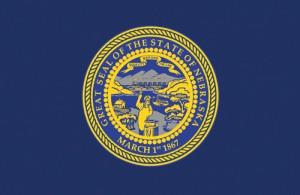 New state government publications have been received at the Nebraska Library Commission for March 2015. Included are titles from the Nebraska Department of Agriculture, the Foster Care Review Board, Nebraska Game & Parks Commission, and University of Nebraska Press, to name a few.
New state government publications have been received at the Nebraska Library Commission for March 2015. Included are titles from the Nebraska Department of Agriculture, the Foster Care Review Board, Nebraska Game & Parks Commission, and University of Nebraska Press, to name a few.
http://nlc.nebraska.gov/publications/archives/WhatsUpDoc/WUDMar2015.pdf
Focus on Nebraska authors: Roger Welsch
I’m not sure many of us could remember who gave our high school commencement address, but I do remember that Roger Welsch spoke at my Senior Honor Banquet. What’s more, I still remember one of the jokes he told; still use it too. I also have fond memories of living in Texas and relishing Roger’s Postcards from Nebraska on CBS Sunday Morning News. And, after working my way straight through college and graduate school with no break and no time for reading anything other than what was assigned, I remember the first book I really enjoyed reading after graduation; It’s Not the End of the Earth, But You Can See it From Here, by Roger Welsch.
We often hear that book clubs are looking for a break from serious titles. If you’re familiar with Welsch’s style, you know that his works might be just the ticket! You can find the following Welsch titles in our book club collection: Catfish at the Pump: Humor and the Frontier, Everything I Know About Women I Learned From My Tractor, From Tinkering to Torquing: A Beginner’s Guide to Tractors and Tools, It’s Not the End of the Earth, But You Can See it From Here: Tales of the Great Plains, A Life With Dogs, and Shingling the Fog and Other Plains Lies. Please consider selecting one of these books for your book club and let us know when we can reserve them for you.
Posted in Books & Reading, General, Information Resources
Leave a comment
Nebraska Memories: A Collection of Collections
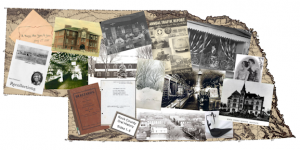 Did you know that Nebraska Memories is a collection of Nebraska cultural heritage collections? When you visit Nebraska Memories, instead of searching for a particular item or person, try clicking on “View Collections.” As a result, you will find Nebraska historical collections from (almost) A-Z. The histories of Nebraska hospitals, cities, towns, counties, public schools, colleges, libraries, musicians, authors, sports and historical events are all represented in the collections found in Nebraska Memories.
Did you know that Nebraska Memories is a collection of Nebraska cultural heritage collections? When you visit Nebraska Memories, instead of searching for a particular item or person, try clicking on “View Collections.” As a result, you will find Nebraska historical collections from (almost) A-Z. The histories of Nebraska hospitals, cities, towns, counties, public schools, colleges, libraries, musicians, authors, sports and historical events are all represented in the collections found in Nebraska Memories.
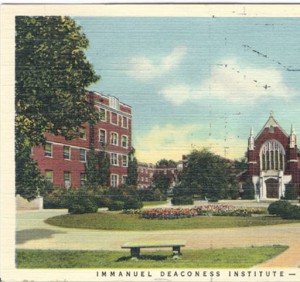 For example, the first collection listed is the Alegent Health Immanuel Medical Center. The rich and well documented history of Immanuel Medical Center in Omaha, Nebraska is shown in the images of the early buildings, people and artifacts. The archive of thousands of photos, papers and items has been maintained for over 120 years, carefully stored and currently housed at the Alegent Health Immanuel Medical Center campus.
For example, the first collection listed is the Alegent Health Immanuel Medical Center. The rich and well documented history of Immanuel Medical Center in Omaha, Nebraska is shown in the images of the early buildings, people and artifacts. The archive of thousands of photos, papers and items has been maintained for over 120 years, carefully stored and currently housed at the Alegent Health Immanuel Medical Center campus.
Other collections in Nebraska Memories include city and county historical societies, such as the Crawford, Fairmont/Filmore County, Hastings, Antelope County, Butler County, and Phelps County, to name a few.
Historical materials related to the Lincoln Public Schools have been collected and saved in some form in various offices, library sites, and schools since the inception of the first school in Lancaster county. Over the years, LPS Library Media Services has made great progress in collecting, preserving, and archiving the history of LPS for the staff and the public.
 There are other unique collections in Nebraska Memories as well: the Omaha Community Playhouse (pictured right), that includes digitized images of the Playhouse and some of its performances; the Lincoln Police Department, that includes digitized images of police officers from 1885-1907; the Durham Museum in Omaha, with the William Wentworth Collection that consists of 4663 negatives of images that document life in Omaha, Nebraska from 1934 through 1950; and the Bess Streeter Aldrich House and Museum in Elmwood, Nebraska (pictured below), images of which have been selected to give the viewer a deeper understanding of the influences and inspirations that Bess Streeter Aldrich drew upon when writing the 1928 novel “A Lantern in Her Hand.
There are other unique collections in Nebraska Memories as well: the Omaha Community Playhouse (pictured right), that includes digitized images of the Playhouse and some of its performances; the Lincoln Police Department, that includes digitized images of police officers from 1885-1907; the Durham Museum in Omaha, with the William Wentworth Collection that consists of 4663 negatives of images that document life in Omaha, Nebraska from 1934 through 1950; and the Bess Streeter Aldrich House and Museum in Elmwood, Nebraska (pictured below), images of which have been selected to give the viewer a deeper understanding of the influences and inspirations that Bess Streeter Aldrich drew upon when writing the 1928 novel “A Lantern in Her Hand.
 Visit Nebraska Memories to search for or browse through many more historical images digitized from photographs, negatives, postcards, maps, lantern slides, books and other materials.
Visit Nebraska Memories to search for or browse through many more historical images digitized from photographs, negatives, postcards, maps, lantern slides, books and other materials.
Nebraska Memories is a cooperative project to digitize Nebraska-related historical and cultural heritage materials and make them available to researchers of all ages via the Internet. Nebraska Memories is brought to you by the Nebraska Library Commission. If your institution is interested in participating in Nebraska Memories, see Introduction to Participating in Nebraska Memories for more information, or contact Beth Goble, Historical Projects Librarian, or Devra Dragos, Technology & Access Services Director.
The Data Dude – Public Library Survey Thank You
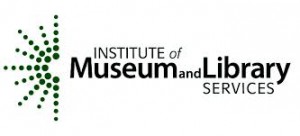 The IMLS public library survey is now locked and Bibliostat will be compiling all the data from the submitted surveys. Thank you all for completing these. Our response rate was around 85%. Please send me any feedback on the survey, tweaks that can be made to next year’s report, or any suggestions about how the survey experience might be more pleasant. I also want to send an additional reminder to complete your supplemental survey if you haven’t done so already. Use your Bibliostat ID and password to access this. Actually, the supplemental survey it is more like a directory update, and it can be done at any time throughout the year. Please update it when your information changes (e.g. board members, staff members, phone numbers, etc.). This information is used to keep websites and directories up to date, and it won’t take you too much time to review this information. Shaka.
The IMLS public library survey is now locked and Bibliostat will be compiling all the data from the submitted surveys. Thank you all for completing these. Our response rate was around 85%. Please send me any feedback on the survey, tweaks that can be made to next year’s report, or any suggestions about how the survey experience might be more pleasant. I also want to send an additional reminder to complete your supplemental survey if you haven’t done so already. Use your Bibliostat ID and password to access this. Actually, the supplemental survey it is more like a directory update, and it can be done at any time throughout the year. Please update it when your information changes (e.g. board members, staff members, phone numbers, etc.). This information is used to keep websites and directories up to date, and it won’t take you too much time to review this information. Shaka.
What did it really look like?
It seems like every few weeks a news story about a photo of a model or celebrity being retouched makes the rounds. The topic of photo manipulation or retouching is not new but did you realize that the manipulation of images has been going on since the 1800’s? I don’t know a lot about how this early manipulation was done but they used many techniques including hand-coloring black and white photos and negatives and combining pieces of multiple pictures and negatives to create a new image. What I do know is that there are many great examples of postcards in Nebraska Memories that feature images that have been manipulated.
What I do know is that there are many great examples of postcards in Nebraska Memories that feature images that have been manipulated.
Let’s start by looking at an obvious manipulation. This postcard is captioned “Fishing on Pibel Lake, Nebraska”. Look at the size of that fish. It is almost as big as the boat. If you want to try catching a big a fish like that you can visit Pibel Lake as it is a Nebraska State Recreation Area. (Update – The Pibel Lake Recreation Area is now owned by the Lower Loup Natural Resources District)
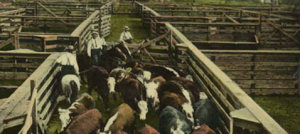 Looking at this postcard captioned “Among the cattle pens, stock yards, South Omaha, Neb.” you can see that color has been added but I think they got something wrong. Have you ever seen healthy green vegetation growing in an active stockyard? Growing up I drove past these stockyards many times. I don’t remember them ever being this lush and green looking when they were filled with cattle.
Looking at this postcard captioned “Among the cattle pens, stock yards, South Omaha, Neb.” you can see that color has been added but I think they got something wrong. Have you ever seen healthy green vegetation growing in an active stockyard? Growing up I drove past these stockyards many times. I don’t remember them ever being this lush and green looking when they were filled with cattle.
Sometimes looking at a single postcard you may realize that color has been added unless you can compare it to the original black and white image or you notice something odd you may think the coloring looks good. It would be fun if we could compare the original image to the enhanced version but unfortunately we don’t have that option. In Nebraska Memories we do however have multiple postcards of the same scenes.
There are two postcards in Nebraska Memories captioned “Partial view of stock yards, South Omaha”. One is black and white while the other one has had color added. Looking at these postcards is a great way to see how adding color changes an image.
These next two postcards appear to be created from the exact same image however the manipulation that was done to them is slightly different. The postcards are captioned Stock pens, South Omaha, Neb. and Stock pens, south side, Omaha, Neb.. Some of the differences between these two postcards are obvious such as making the roofs have a reddish cast to them. Also the postcard on the top has an overcall darker feel to it. 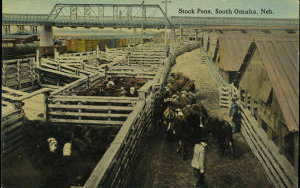
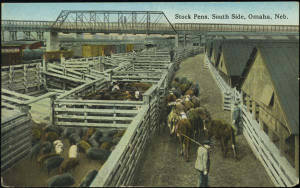 To see these next differences you may need use to above links to look at the actual items in Nebraska Memories where you will be able to zoom in on the postcards. Starting at the bottom left on the postcards do you see the animals in the pen? On one postcard they clearly look like pigs while on the other they look like black blobs. Moving to the right do you see the man standing behind the cattle? On the postcard with the pigs that you can see you will notice that the man is carrying some type of stick over his shoulder while on the other postcard the stick has been colored black and it blends in with the cattle. Next follow the fencing until you locate the man standing on top of the fence. Do you see that there is a tall object next to the man that has been removed from one of the postcards? The last differences I want to point out are the color of the taller fence posts next to the train cars. On one postcard the tops of the posts were left white while the train cars around them were colored. On the other card the posts were colored to match the train cars.
To see these next differences you may need use to above links to look at the actual items in Nebraska Memories where you will be able to zoom in on the postcards. Starting at the bottom left on the postcards do you see the animals in the pen? On one postcard they clearly look like pigs while on the other they look like black blobs. Moving to the right do you see the man standing behind the cattle? On the postcard with the pigs that you can see you will notice that the man is carrying some type of stick over his shoulder while on the other postcard the stick has been colored black and it blends in with the cattle. Next follow the fencing until you locate the man standing on top of the fence. Do you see that there is a tall object next to the man that has been removed from one of the postcards? The last differences I want to point out are the color of the taller fence posts next to the train cars. On one postcard the tops of the posts were left white while the train cars around them were colored. On the other card the posts were colored to match the train cars.
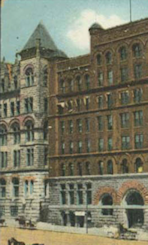 Finally I want to highlight a selection of postcards picturing the Old City Hall and Bee Building. The Old City Hall building was located on the northeast corner 18th & Farnam Streets. The Bee Buidling stood next to it. Both buildings were torn down in 1966 to make way from the Woodmen Tower. Shown here are just a few of the postcards in Nebraska Memories that feature both of these buildings. After looking at all of these postcards I wonder what these buildings really looked like. Because these buildings were not torn down until early in 1966 I would think that there is a color photo of one or both of these buildings available someplace. If you have a color photo of either of these building stashed away or you know where I can see a color photo I would love to see them!
Finally I want to highlight a selection of postcards picturing the Old City Hall and Bee Building. The Old City Hall building was located on the northeast corner 18th & Farnam Streets. The Bee Buidling stood next to it. Both buildings were torn down in 1966 to make way from the Woodmen Tower. Shown here are just a few of the postcards in Nebraska Memories that feature both of these buildings. After looking at all of these postcards I wonder what these buildings really looked like. Because these buildings were not torn down until early in 1966 I would think that there is a color photo of one or both of these buildings available someplace. If you have a color photo of either of these building stashed away or you know where I can see a color photo I would love to see them!
Visit Nebraska Memories to search for or browse through many more historical images digitized from photographs, negatives, postcards, maps, lantern slides, books and other materials.
Nebraska Memories is a cooperative project to digitize Nebraska-related historical and cultural heritage materials and make them available to researchers of all ages via the Internet. Nebraska Memories is brought to you by the Nebraska Library Commission. If your institution is interested in participating in Nebraska Memories, see http://nlc.nebraska.gov/nebraskamemories/participation.aspx for more information, or contact Beth Goble, Historical Projects Librarian, or Devra Dragos, Technology & Access Services Director.
Posted in General, Information Resources, Nebraska Memories, Technology
2 Comments
The Data Dude on Data Visualizations
 The Nebraska Library Association’s Advocacy Day was yesterday. The purpose of this post today is to give you a link to the handouts that were provided for the event, including summaries of the NLC’s new budget request items. Of course, the purpose is also to reiterate the importance of gathering statistical data from surveys and how the collected data might be used. The survey data that Nebraska public libraries provide (e.g. the IMLS public library survey, digital inclusion survey, etc.) make these handouts possible. Another invaluable contributor to the handouts includes public librarians and library visitors, who provided testimonials and photo images. I won’t list all of you that contributed, but you know who you are. Even if you provided something that didn’t ultimately make it into the handout, thank you for your time and efforts. Special thanks go out to Pete and Jaden Ferguson, and the Foundation for the Lincoln City libraries. Pete and Jaden’s flyer from the LCL Foundation’s Idea Place campaign provided the theme for the general handout, and for that reason I would like to express my gratitude and thanks.
The Nebraska Library Association’s Advocacy Day was yesterday. The purpose of this post today is to give you a link to the handouts that were provided for the event, including summaries of the NLC’s new budget request items. Of course, the purpose is also to reiterate the importance of gathering statistical data from surveys and how the collected data might be used. The survey data that Nebraska public libraries provide (e.g. the IMLS public library survey, digital inclusion survey, etc.) make these handouts possible. Another invaluable contributor to the handouts includes public librarians and library visitors, who provided testimonials and photo images. I won’t list all of you that contributed, but you know who you are. Even if you provided something that didn’t ultimately make it into the handout, thank you for your time and efforts. Special thanks go out to Pete and Jaden Ferguson, and the Foundation for the Lincoln City libraries. Pete and Jaden’s flyer from the LCL Foundation’s Idea Place campaign provided the theme for the general handout, and for that reason I would like to express my gratitude and thanks.
If you didn’t attend Advocacy Day, you can see the handouts online. They might be helpful by giving you more information about the current budget requests, as well as some of the statistics and data about Nebraska public libraries. Hopefully, it will also provide some degree of validation for all the work to gather and report public library statistics, especially for those of you that have just completed your public library surveys. Shaka.
Focus on Nebraska authors: Timothy Schaffert
Timothy Schaffert teaches in the English Department at the University of Nebraska-Lincoln, is the director/founder of the (downtown) Omaha Lit Fest, and is a contributing editor to Fairy Tale Review. He grew up in rural Nebraska near the city of Aurora and I had the good fortune to meet him at my neighbor’s house and talk with him about his books. Timothy has written five novels, all of which we own in our Book Club collection. I read the first chapter of each book and one thing was evident in all of them, Nebraska settings and very quirky characters. Timothy writes the kind of literary fiction that book groups are always looking for because they provide rich discussion and strongly-felt opinions. His latest book, The Swan Gondola, is set during the 1898 Omaha World’s Fair and has recently been described as a costume-drama novel every intelligent woman needs to read. The best thing to know about this Nebraska author is that he has attended book group discussions in the past and would consider your invitation if you would like to include him in your discussion. Timothy makes for charming company, so please think about selecting one of his titles and perhaps scheduling an author visit for your group!
Posted in Books & Reading, Information Resources
1 Comment
InnovateHER: 2015 Innovating for Women Business Challenge
 InnovateHER is a cross-cutting women’s business challenge to unearth innovative products and services that help impact and empower the lives of women and families.
InnovateHER is a cross-cutting women’s business challenge to unearth innovative products and services that help impact and empower the lives of women and families.
We know that our workforce looks very different from 50 years ago. Women now make up nearly half of the labor force and play a critical role in our nation’s economic prosperity. Most children live in households where all parents work. And as our population ages, families are increasingly caring for aging parents while balancing the needs of work and home. As demands on women and families grow, the need for products and services that address unique challenges increases. This Challenge will provide that platform.
Challenge Criteria
InnovateHER provides an opportunity for entrepreneurs to showcase products or services that have a measurable impact on the lives of women and families (30%), have the potential for commercialization (40%), and fill a need in the marketplace (30%).
Participants must be at least 18 years of age, U.S. citizens or permanent residents, and meet other requirements as defined in the Competition Rules.
How to Participate
Throughout the month of March, universities, accelerators, resource partners and other organizations will host local competitions. A month after going live, each host will select and submit one local winner to the SBA, who will then identify no more than 10 finalists. Finalists will make a live pitch to a panel of expert judges during National Small Business Week, May 4 – 8, 2015, in Washington, D.C. where they will compete for top three awards and prize money totaling $30,000.
Finalists will be responsible for covering their own travel costs to DC for the national competition.
2015 InnovateHER Local Competitions – Updated
View a map of InnovateHER host organizations
Download the list of locations and contacts as a spreadhseet
SBA will continue to update this list as additional host organizations are confirmed.
More Questions?
- Read our Frequently Asked Questions
- Contact us at womenbusiness@sba.gov (link sends e-mail)
Grand Island to Host Conference Dedicated to Growing Women Entrepreneurship in Nebraska
 To help celebrate Women’s History Month in March, the U.S. Small Business Administration and the Rural Enterprise Assistance Project’s Women’s Business Center will host a day of speakers designed to inspire and offer down-to-earth advice for women to start or grow a small business.
To help celebrate Women’s History Month in March, the U.S. Small Business Administration and the Rural Enterprise Assistance Project’s Women’s Business Center will host a day of speakers designed to inspire and offer down-to-earth advice for women to start or grow a small business.
The Women Entrepreneur Conference is scheduled for Wednesday, March 18 from 8 a.m. to 3:30 p.m. at the YWCA of Grand Island, 211 East Fonner Park Road.
Patricia Brown-Dixon, Region VII Administrator, U.S. Small Business Administration and Rebecca Greenwald, Region VII Advocate for the SBA, will offer remarks. Additionally, among those on the agenda are:
- Jennifer Rosenblatt of Argyle Octopus, a marketing firm which took home the award as the SBA’s Small Business of the Year for the 1st Congressional District in 2014;
- J’Nan Ensz, Accounting & Business Consulting Group, LLC;
- Speakers from the University of Nebraska-Lincoln Entrepreneurship Legal Clinic;
- And, Kitty Vacha, owner of Tasteful Indulgence, Cake Art of Seward; Megan Gewecke of Stepping Stones Psychological Services, LLC; and Sally Jurgensmier, owner of sculptures by SALLY, will serve on a panel of local entrepreneurs who will share their challenges and successes as women small business owners.
The event also will offer a half-hour fun and fast networking event hosted by Lisa Tschauner and Megan Arrington of Open For Business Magazine, to connect entrepreneurs with resource providers and other small businesses.
According to figures provided by the SBA Office of Advocacy, 6.6 percent of women in Nebraska are self-employed, and women represent 32.5 percent of all small business owners. Small businesses significantly impact Nebraska’s economy. They represent nearly 97 percent of all employers and employ 48 percent of the private-sector labor force. The latest data shows 167,678 small businesses in the state.
The $35 registration fee also covers lunch and may be paid at the door. Register online at http://events.sba.gov/eventmanagement/EventRegistration.aspx?id=9bc4ad23-d99c-e411-8f7e-02bfa56e2a24.
For more information, please call Monica Braun, REAP Women’s Business Center Director at (402) 643-2673 or Elizabeth Yearwood, Economic Development Specialist at the SBA, at (402) 221-7200.
For more information regarding SBA, please visit our website at: www.sba.gov/ne.
New Government Publications Received at the Library Commission
 New state government publications have been received at the Nebraska Library Commission for February 2015. Included are titles from Administrative Services, Colleges and Universities, Education, and Public Power, to name a few.
New state government publications have been received at the Nebraska Library Commission for February 2015. Included are titles from Administrative Services, Colleges and Universities, Education, and Public Power, to name a few.
http://nlc.nebraska.gov/publications/archives/WhatsUpDoc/WUDFeb2015.pdf
The Data Dude on Other Materials
 This week, the Dude looked at a part of the public library survey that is often forgotten, element number 4.33, Description of Other Materials. In Nebraska, the leader in this category is cake pans (74), followed by puzzles (33), and discovery packs (9). Others include some fairly obvious choices such as framed art, sculpture, watt meters, toys, puppets, eReaders, games, gaming equipment, and quilt patterns. Some not so obvious choices (but good ideas) include grief kits (Bellevue Public Library), compasses (Lied Randolph Public Library), CD/DVD cleaners (Sidney Public Library), umbrellas and Frisbees (South Sioux City Public Library), overhead projector (Verdigre Public Library), and a Moon Kit (Yutan Public Library). It’s important to note that the other item holdings often differ based on the unique needs of the local communities. Another other material that is worth mentioning is the seed exchange (although the Crete Public Library is the only public library to report this on their survey, there certainly are more Nebraska libraries doing this). While seed exchanges are, technically illegal (but generally unenforced) due to antiquated legislation, there is a current bill in the Nebraska Legislature to legitimize seed exchanges by adopting the Community Gardens Act. But while part of the focus of this post is to applaud these other materials offerings, it also is to point out what is missing from it.
This week, the Dude looked at a part of the public library survey that is often forgotten, element number 4.33, Description of Other Materials. In Nebraska, the leader in this category is cake pans (74), followed by puzzles (33), and discovery packs (9). Others include some fairly obvious choices such as framed art, sculpture, watt meters, toys, puppets, eReaders, games, gaming equipment, and quilt patterns. Some not so obvious choices (but good ideas) include grief kits (Bellevue Public Library), compasses (Lied Randolph Public Library), CD/DVD cleaners (Sidney Public Library), umbrellas and Frisbees (South Sioux City Public Library), overhead projector (Verdigre Public Library), and a Moon Kit (Yutan Public Library). It’s important to note that the other item holdings often differ based on the unique needs of the local communities. Another other material that is worth mentioning is the seed exchange (although the Crete Public Library is the only public library to report this on their survey, there certainly are more Nebraska libraries doing this). While seed exchanges are, technically illegal (but generally unenforced) due to antiquated legislation, there is a current bill in the Nebraska Legislature to legitimize seed exchanges by adopting the Community Gardens Act. But while part of the focus of this post is to applaud these other materials offerings, it also is to point out what is missing from it.
So what is noticeably absent? Tools. Not one Nebraska public library reported having tools of any sort. Why is there more of an emphasis on baking a cake than a bathroom remodel? You say cake pan, I say wet saw, lawn aerator, or sawzall. Is it a liability issue? Perhaps. Maintenance issue? Sure, it could be. Expense? Likely, yes. Gender? I dunno. Could it simply be that tools are loaned person to person, and a library isn’t necessary? Possibly. There isn’t a local outcry for tool offerings? Maybe not, but is there a local outcry for cake pans? Conceivably, there could be more investment in a comprehensive tool library and time consumption for maintenance. Now that the Dude has exhausted all synonyms for the word maybe, what about basic or specialty tools that probably aren’t real expensive? What about donated tools? You see, the Dude recently is in the process of working on cleaning a clogged bathtub drain and in the process of the strainer extraction, he broke the screw holding the drain together. Guess what he now needs? A special extraction tool. The Dude will most likely purchase this tool (it’s still cheaper than calling a plumber), and probably only use it once (if it is needed at some point down the road undoubtedly it will become lost in sea of other garage residents or forgotten altogether). This is the kind of thing that would be an ideal choice for donation to a tool library.
But the point of all this is not to say rush out and get sets of tools (or Frisbees, or moon kits, or framed art), but to say what does your community value? How can you achieve the goals of providing things that are important to them? How do you know? What about bringing local community talents together for programs, then evaluating interest?
Finally, the Sacramento Public Library is worth noting, as they have jumped into the deep end of this sort of thing, implementing a Library of Things project. The idea is that many residents of their community don’t have the money or storage space for things they don’t often use but occasionally need. The Sacramento Public Library funded its Library of Things from a $10,000 LSTA grant. They set up a separate webpage to collect votes for “arts and innovation” items requested to be made available. You might get ideas from the top vote getters, which were card or board games for children and adults (196 votes); craft tools such as sewing machines and others (183 votes); musical instruments (178 votes); Go Pro cameras (177 votes); camping kits (160 votes); artifacts for the classroom/school students such as WW II memorabilia and other things that illustrate life in earlier times (143 votes); and a binding machine for creating your own books, journals, etc. (134 votes). Some of the Dude’s favorites, but not necessarily top vote getters include garden tools (e.g. loppers, rototillers, etc.), old school/nostalgic video game systems (think Atari, Nintendo, etc.), button makers (hey, the Dude has an upholstery button maker he hasn’t used in about 12 years. Perfect!), food dehydrators, Karaoke machines, carpet steam cleaners, telescopes, basic wood tools, ladders, bread machines, unicycles, bike tool kits, paint sprayers, Kreg Jigs, a drone with HD camera, chain saws, and soldering irons. The Dude would add croquet sets/bocce balls and surfboards or stand up paddleboards to the list. The boards are worth noting because they still are on the Dude’s to-do list for making as soon as the garage gets cleaned out. The Dude is still deciding whether or not to try a hollow SUP type board or a more classical Alaia (Tom Wegner is the master of this craft). The other advantage to having these sorts of things in a library is that they can be found, unlike many things that reside in the Dude’s garage, but are impossible to locate when needed. Shaka.
Focus on Nebraska authors: Mary Pipher
If your book group would like to select a nonfiction title to read, let me suggest getting to know Mary Pipher. Mary lives in Lincoln with her husband Jim and has written 9 books – four of which we have in our Book Club collection. My book group read The Middle of Everywhere a few years ago and as the setting for the text is Lincoln, many people recognized several locations and people mentioned. That is always an intriguing element of a book with a local author. The book is also informative as Mary presents Lincoln as a refugee relocation center and illustrates how new citizens of Lincoln need assistance. She coins the expression cultural broker and explains the sorts of ways she provides help to refugees earnestly trying to make the United States their home. My group had an excellent discussion with this title and I think yours could too.
A colleague and I both read Seeking Peace: Chronicles of the Worst Buddhist in the World at the same time and had great discussions. With this book we learned about Mary’s background and her personal life especially in terms of negotiating balance between her family and promoting her books. Mary read from this book at the Nebraska Book Festival sponsored by the Nebraska Center for the Book and it was a pleasure hearing her voice present her own text.
Posted in Books & Reading, General, Information Resources
Leave a comment
NCompass Live: Thirteen Things You Might Not Know About National Library of Medicine Resources
 Join us for next week’s NCompass Live, “Thirteen Things You Might Not Know About National Library of Medicine Resources”, on Wednesday, March 4, 10:00-11:00 am Central Time.
Join us for next week’s NCompass Live, “Thirteen Things You Might Not Know About National Library of Medicine Resources”, on Wednesday, March 4, 10:00-11:00 am Central Time.
Where are you going to look? The answer should be the National Library of Medicine…for topics such as human anatomy, animal disease, health organizations, doctors, drugs, low-cost care and medicine, diagnostic tests and more. Marty Magee, from the University of Nebraska Medical Center’s McGoogan Library of Medicine, looks at reference and consumer resources beyond MedlinePlus.gov, that are freely accessible for patrons and libraries everywhere.
Upcoming NCompass Live events:
- March 11 – Getting More $$ from Your Book Sales OR Is This Old Book Valuable?
- March 18 – Discount Shopping with the NLC
- March 25 – Tech Talk with Michael Sauers
For more information, to register for NCompass Live, or to listen to recordings of past events, go to the NCompass Live webpage.
NCompass Live is broadcast live every Wednesday from 10am – 11am Central Time. Convert to your time zone on the Official U.S. Time website. The show is presented online using the GoToWebinar online meeting service. Before you attend a session, please see the NLC Online Sessions webpage for detailed information about GoToWebinar, including system requirements, firewall permissions, and equipment requirements for computer speakers and microphones.
The Data Dude on Motion Charts
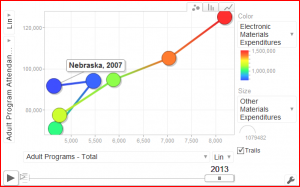 Shaka. Today, the Dude will focus on Google motion charts. This may be a complex or simple matter (depending on your perspective and degree of tech-savviness). It also may depend on your interest in data displays, which might currently be in the toilet after looking at all the survey data you have been reporting. This won’t stop the Dude from making a feeble attempt to show how the data you collect and report might be valuable to illustrate library trends, and that may rescue those that hold to the belief that there is excessive frivolity in the survey reporting.
Shaka. Today, the Dude will focus on Google motion charts. This may be a complex or simple matter (depending on your perspective and degree of tech-savviness). It also may depend on your interest in data displays, which might currently be in the toilet after looking at all the survey data you have been reporting. This won’t stop the Dude from making a feeble attempt to show how the data you collect and report might be valuable to illustrate library trends, and that may rescue those that hold to the belief that there is excessive frivolity in the survey reporting.
First, some background information (or filler material). The Dude was introduced to the motion chart (aka interactive bubble chart) by Hans Rosling’s TED talk. Watch it and you will be entertained. The software for the bubble (or motion) chart was created by Rosling’s Gapminder Foundation. In 2007, the motion chart was acquired by Google, and now anyone can create these interactive charts with a free Google account. The Dude will skip the steps on how to get the data into the chart (that will be saved for another day), but basically you load a spreadsheet and tweak the columns a bit.
The chart above is a static version from a motion chart the Dude created with the data from the Nebraska public library surveys from 2007 to 2013. It encompasses all the reported data for libraries in the state. The bubble (in this case there is only one, but you can add many more if you create your own chart) represents the size of the entity (typically population, and in this case the total legal service population of Nebraska libraries). There are two axes and the data for either one can be changed by clicking on the little arrow next to the description. There is a slider at the bottom that has a play button to set everything in motion by time. When you do this, the bubble moves either up or down depending on the changes in the data on the vertical axis. Simultaneously, the bubble moves either left or right, depending on changes in the data on the horizontal axis. In this example, the Dude compared the number of adult programs to adult program attendance (if you load the actual motion chart from the link above, you will have to select this from the menu bars on the left and the bottom). As you can see from the static image, programs went up with attendance remaining mostly the same from 2007 to 2008, then there was a decrease in programs and attendance from 2008 to 2009, and then a nice, consistent increase in both from 2010-2013.
As with anything else, sometimes the motion chart might not always be the best choice for your data visualization. Andrew Abela has created this nifty chart chooser to help you decide what visualization you might want to use, depending on what trend you might like to show. The Dude is working on more motion charts, with more bubbles, perhaps to take the public library survey data and illustrate all the libraries and their data together, or perhaps just a particular library and its peers. Any feedback on this project would be nice to have, and if any of you need assistance with motion charts, feel free to let me know.
The Data Dude – Game of Thrones Data Visualization
 Well, this week’s post almost didn’t happen because the Dude has been swamped with surveys, Monday was President’s Day, and the Dude is home today with a sick kid. As an update to the public library survey (the deadline was last Friday the 13th), thank you e-mails have been sent out to those of you who have submitted and finalized your surveys. There are some surveys that have issues that are in need of a little TLC, and you should have received e-mail questions or calls about those by now. If all your issues are cleared up (or if you had no issues to begin with) you should have received an e-mail about the supplemental survey. If you haven’t, please let me know and I will check on the status of your survey. Since the Dude is still working on finalizing some surveys, wait a few weeks for the final numbers on our survey response rates.
Well, this week’s post almost didn’t happen because the Dude has been swamped with surveys, Monday was President’s Day, and the Dude is home today with a sick kid. As an update to the public library survey (the deadline was last Friday the 13th), thank you e-mails have been sent out to those of you who have submitted and finalized your surveys. There are some surveys that have issues that are in need of a little TLC, and you should have received e-mail questions or calls about those by now. If all your issues are cleared up (or if you had no issues to begin with) you should have received an e-mail about the supplemental survey. If you haven’t, please let me know and I will check on the status of your survey. Since the Dude is still working on finalizing some surveys, wait a few weeks for the final numbers on our survey response rates.
With the Dude suffering from a bit of a survey hangover, there is a shortage of material for this week’s post. Now, some of the abstract ideas ranged from word clouds, stories about robots in libraries, and more statistics on technology. But let’s be honest; the Dude finds most word clouds to be a bore, so they will be saved for another day when boring is on the menu. So for today the Dude will keep it simple, and note his interest in Reddit’s DataisBeautiful, mostly because the data there is usually interesting but also because it is often uniquely presented. Using data in a simple way such as this not only gets a point across, but fits the innovative bill as well. Enter this image, illustrating the number of deaths in George RR Martin’s Song of Fire and Ice series. For GOT fans, the image says it all. For the record, the Dude is a fan of the HBO series (since the Dude doesn’t have cable, he wishes to thank Lincoln City Libraries for selecting the DVD’s in their collection), but found the books (after about the first 1/3 of Storm of Swords) to be long-winded. The Dude ain’t afraid to say it. Shaka.
SBA Has a New Online Tool To Match Lenders To Entrepreneurs
The Small Business Administration is launching a first-of-its-kind tool on their website that will allow entrepreneurs looking for a small business loan to get matched with a SBA lender. This new tool, called LINC (Leveraging Information and Networks to access Capital) will have small business owners fill out a simple online form of 20 questions and connect them with lenders within 48 hours. By directly connecting with prospective borrowers, the agency will be able to provide more guidance and ensure more capital is reaching our nation’s entrepreneurs.
“LINC will bring entrepreneurs and SBA lenders together. There’s a hunger among entrepreneurs to find financing to get their business off the ground or take the next big step in their expansion plan. The SBA stands there ready to help them, now with a few simple clicks,” said SBA Administrator Maria Contreras-Sweet. “Across the country, thousands of small business owners pound the pavement every day looking for term loans, equipment financing, lines of credit, invoice financing, and real estate loans to help them hire and grow. If you have a bankable business idea backed by good credit and sound financial planning, the SBA wants to streamline the process for you to get the capital you need.”
After filling out the form, a borrower’s answers will be sent to every lender in that borrower’s county, as well as to other lenders with a regional or national reach. Once lenders have reviewed the information that matters most to them, they’ll respond within 48 hours, all this for no fees or commitment. This option will untether entrepreneurs from the one neighborhood bank, using technology to get their foot in the door at any number of institutions and improve their access to capital.
LINC will roll out in waves. It will begin by connecting small business owners with nonprofit lenders that offer free financial advice and specialize in micro lending, loans in our Community Advantage program, and real estate financing. In the longer-term, SBA will look to add more traditional banks that offer an even wider array of financial products.
As of the launch of LINC, 124 lenders across SBA’s lending programs are participating in the outreach effort, operating in all 50 states, DC, and Puerto Rico. Since 2009, these borrowers have made more than 42,000 SBA loans, totaling more than $17 billion. Prospective borrowers may immediately go to https://www.sba.gov/tools/linc.
